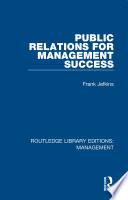
Public Relations
Made Simple
Public Relations discuss the historical background, organization, definition, and promotion of the subject as a management function. The factors that influence public expectations of public relations are presented in detail. A section of the book enumerates the characteristics of an effective PR practitioner. Such factors as ability to communicate, organize, interact with people, having personal integrity, and imagination are explained thoroughly. The book provides a comprehensive discussion of the common and statute law affecting public relations. It also reviews the types of defamation like slander and libel. The topic copyright is explained. A section of the book covers the product’s life cycle. This subject includes the packaging, distribution, sales force, market education, promotion, and merchandising of the product. It is important that management- employee relations should be stimulated by PR techniques. These techniques can be in the form of house journals, notice-boards, audio-visual, speak up schemes, shop-floor talks, staff conferences, and other get-togethers. The book will provide useful information to reporters, advertisers, commercial developers, students and researchers in the field of marketing.
- ISBN 13 : 1483183173
- ISBN 10 : 9781483183176
- Judul : Public Relations
- Sub Judul : Made Simple
- Pengarang : Frank Jefkins,
- Kategori : Social Science
- Penerbit : Elsevier
- Bahasa : en
- Tahun : 2016
- Halaman : 286
- Google Book : https://play.google.com/store/books/details?id=brZlDAAAQBAJ&source=gbs_api
-
Ketersediaan :
The factors that influence public expectations of public relations are presented in detail. A section of the book enumerates the characteristics of an effective PR practitioner.


